“As a fisherman and pedestrian I had been able to come at the stream only at certain points: now the most private and secluded retreats of the nymph would be opened to me; every bend and eddy, every cove hedged in by swamps or passage walled in by high alders, would be at the beck of my paddle.” – John Burroughs, “Pepacton: A Summer Voyage,” 1881.
THIS SUMMER I went kayaking not far from my house. There was a drought; the water was low and paddling north a mile or so we found ruins. Abandoned sidewalks abruptly ended in the water. Stairs climbed to nowhere; old stanchions that suggested some kind of industrial purpose sat at crooked angles on the shale shore. A capsized culvert half in the water emerged each week another few inches until it was entirely beached and looked like a tunnel to nowhere, while piles of rusting metal scrap – horseshoes and hooks and pulleys – spread across the ground, staining it orange. Roads appeared, and bridges rose from the depths as if to show an alternate universe. This was the lost village of Arena.
It sounds kind of mystical, no? To call this place “lost,” though, is to underestimate the matter. The village is like a wound that doesn’t heal. Arena was flooded to build the Pepacton, one of New York City’s reservoirs. Its name is Lenape for “marriage of the waters,” but the marriage isn’t exactly one of equals. Here the East Branch of the Delaware River is dammed and nearly 250 million gallons a day flow to New York City. Drive the 50-some miles around the reservoir, and the roads are dotted with haunting signs: “Site of the former village of Union Grove.” “The former village of Arena,” “The former village of Shavertown…” all those formers buried under water – farmland, trains, gas stations, stone walls…. The cemeteries, however, were moved.
People here don’t much like the city. By “city” they mean the agency in charge of the reservoirs, the New York City Department of Environmental Protection, but often the two are conflated. The words slip and talk of “the city” can sound like they mean all of the city – or its people. But, this isn’t an us/them or urban/rural or even a red V. blue political issue. It’s not a fear of outsiders you might expect to find in a small town, though there’s plenty of anger about the city’s perceived meddling. The problem is water. It’s everywhere here – and all of it to drink.
Transforming that water into drinking water, that magic act that gets it to come out of a faucet in Fort Green or Greenpoint, Park Slope or the Upper East Side, happens nearly a hundred miles away from those places, where that miracle feels not so miraculous. New York City is the largest metropolis with an unfiltered water system, that’s just over a billion of gallons a day in flushes and cups of tea and coffee and glasses of water, dishes washed, dinners cooked, hands cleaned, showers, laundry…. New York’s era of skyscrapers couldn’t have happened without water. They require water for sprinklers. But also the cement to build them? Water. Water, water, water….
To many in the Catskills though, the region feels like a colonial territory under a foreign government’s control in which residents have no say – all because of the water. The city (by which I mean the NYC government) is the area’s largest landowner, and it keeps that land from being developed or farmed, contributing to depopulation, gutting the economic and tax bases. And, the city has to keep buying more land to protect its resource. The city even has its own police force here, a hundred miles away. It’s the only municipality I know of in the US that has cops patrolling a jurisdiction outside their city limits – all to protect the water.
~
The first time I came upstate, I was 22, maybe, and a boyfriend who had family here brought me to visit. I remember asking if the water was okay to drink. He laughed and waved at the surrounding hills. We were at a lake. “Don’t you know,” he said, “this is your water. This is where all of New York City’s water comes from and it’s great. It’s the best in the world.” (Also a point of pride here is the quality). Needless to say, I didn’t drink bottled water that weekend. I also didn’t really think about what he was saying or about how the water got to the city or what that meant. So, it came from Upstate? I didn’t even know there were reservoirs let alone how they worked or that water was transported. I certainly didn’t know it wasn’t filtered. Like many in the city the water I drank was disconnected from its source, just another element of life you can take for granted, not intentionally, not as if I was being callous about it. It’s just easy not to know, or, if you do know, not to think about the mechanics of it, like electricity. You know where it comes from but don’t think about the actual coal mine in Twilight, West Virginia, and the coal power plant in Phoenixville, Pennsylvania, or the hydroelectric dam on Niagara Falls it takes to turn on your lamp or laptop.
The boyfriend and I broke up, and a few years later silver boxes started popping up around the city to sample the water. When I saw them, I thought briefly of the boyfriend, the lake, the hills, his wave and his proud boast about the water. The boxes looked like some kind of Victorian tardis. In a sense they were. The reservoir system has its origins in the 19th century. At the turn of the century as the city began to transform into the city we know, officials started looking further afield for water for the burgeoning population and towering buildings that started to gleam across the metropolis. At the same time agents for the Ramapo Water Company did too, signing leases in the Catskills for water rights like so many oil company’s land-men. Ramapo had enough foresight to see the demographic shifts first. Soon, though, water was deemed a public good, and the city got the leases.
In 1905 it started work on its first upstate reservoir, the Ashokan. Farms, villages, mills, stores and churches were seized by eminent domain and flooded. By the 1940s, the Bureau of Water Supply, as the agency was called then, got north and west enough to reach my part of Delaware County. At the time there were two railroads, one cutting east and west another north and south, and my village, the prosaic-sounding Margaretville, was the big city for the smaller villages dotting the East Branch. The town had three car dealerships, two drug stores, a movie theater…. None of which, except for Miller’s Drugs, still exist. Some would have disappeared anyway with the demographic shifts after World War II. The reservoir’s building coincided with rural depopulation and the slow death of family farms, but the Pepacton and its marrying waters multiplied those effects.
~
I’ve been thinking much about this since this was the first summer the city has allowed kayaking on the reservoir. For years it seemed like a tantalizing promise, just out of reach, that is unless you were fishing, which got a dispensation. Otherwise: “No trespassing. Under penalty of law” or so the posted signs promised. (Given the sheer number of acres the city owns here, it would be impossible to patrol all of it.) I’ve also been thinking much of the reservoir and its issues because of the 40th anniversary of the Clean Water Act a few weeks ago. It might have cleaned up rivers and waterways across the country, but the law also now has everything to do with daily life where I live.
The Clean Water Act protects drinking water like the stream three feet from my house. Less than 60 days after it flows past my kitchen door that water comes out of someone’s tap in the city. The DEP dictates where and how and when I can use the stream or repair its walls. I understand why, but it’s also a pain, particularly given that they’re 19th century laid up stone walls and erode every time there’s high water – not to mention a flood. Repairing them requires cement; cement requires a permit; the permit requires a dam to reroute the water…. The requirements are too onerous. The wall remains unfixed. It collapses more, getting closer to my foundation. And this is just one tiny, very personal example. The regulations impact farming and forestry – often, as with my stream, requiring best practices. These are good. I being a liberal eco-conscious person support them. Truly I do not want to harm the water or fish. I want dairy farms to manage their manure and run-off, but the regulations can be daunting.
The reservoirs here obviously predate the act, but when it became law, the EPA started monitoring them. (And, just to say, recently the city’s was deemed superlative. The Association of Metropolitan Water Agencies gave the city the Platinum Award, which, you know, means good. It’s platinum, after all). Come the 1990s and that water wasn’t so good, or so the EPA said. The federal agency started questioning the quality. There was an ultimatum demanding a filtration system. That would have cost NYC billions—at the time somewhere in the range of $9 billion. The city pleaded poverty and to mollify the EPA was required to protect the water supply better, which meant more involvement in the Watershed – buying more land, policing more – all the things that make local residents angry. The city signed an agreement with the Catskills watershed towns, which laid out the terms. The city would build and pay for and run sewage plants. It would replace for free any aging septic system. And, it would set aside a nearly $60 million fund to invest in water-friendly Upstate businesses with low-interest loans. To many that seemed like a lot. Now resentment spills out, literally spills into, the water.
The city pays tax on its land here, but it’s vacant, undeveloped and never to be developed, so taxed at a lower rate. The city also often challenges its assessments. In my village the DEP argued down its assessment on the wastewater treatment (read sewage) plant by half. The DEP can afford many lawyers; a village of 600 can’t, so any time the city challenges an assessment, it wins, and the issue isn’t academic or abstract. Making up the shortfall falls on the community (a community in a county often ranked the second poorest in the state). Is it any wonder pickups sport “DEP Off Our Backs” and “Save The Locals” bumper stickers? Even if you’re sympathetic to the city’s need for water, it’s hard not to feel angry.
The editor of my local weekly, a smart guy in whose family the paper has been for a century now, says, “It would have been more fair if in 1996 the city had used eminent domain and condemned all the private property. That way businesses could get a fair valuation at what they had been worth vs. starving us out – and some,” he says, “think that’s just what the city wants to do.” With fewer business, the city has all water and no worries. “And,” he continues, “they could have left some vacation homes here for second-home owners.” The way he puts it is provocative, but he’s also serious, and the picture he paints is a Disney version of the sticks, as if the entire region were run for the needs of those downstate with the water and stately hills and clean air and relaxation.
A couple weeks ago a neighbor you might well call a good old boy in jeans and work boots, t-shirt flapping loose in the breeze and wool shirt tied at his waist was walking through fields adjoining a parcel of city land. He was carrying a compound bow. It was the start of bow-hunting season, and as he walked, only half expecting to run into a doe, he said, “The city, they could at least pay for the water. Just ten cents on every hundred gallons—and their share of taxes.” Now ten cents might not sound like much, but at a billion gallons a day….
On Facebook this summer someone with liberal politics and from a longstanding local family railed about the city as “occupiers.” “Like,” he wrote, “Great Britain occupied foreign lands. The city not only controls the police, it establishes the laws, and chooses when, where and against whom to enforce them. The long-term net effect of the reservoirs and rules, regulations and people enforcing them has been to cause serious economic harm to the area. The reservoirs themselves mark huge economic dead zones where almost all commerce is forbidden. Building and improvement is utterly prohibited, and rippling out from the edges of these economic dead zone, a declining economy can be seen eating away at the hearts and souls of nearby hamlets and villages.”
Even the DEP cops don’t much like the agency. They’re in a bitter contract dispute with the city that’s gone on for years now. A sergeant patrolling the Yonkers reservoirs has turned EPA whistleblower. He lives in Brooklyn and refuses to pay his water bill as his own small act of resistance. The EPA has also been telling the DEP for more than a decade that it needs to improve community relations.
~
Up Cemetery Road, Steve Miller lives in his parents’ old home. Built in 1953, it’s a replica of the family farmhouse in Union Grove. Pretty much all that’s left of the hamlet now hangs off the kitchen porch: a sign for the Union Grove Post Office. Steve’s mother was the post mistress, and as a child he watched the dam being built. Impressed by the engineers’ work, he grew up to be an engineer too, working on the state’s last large construction project, I-88 cutting through from Binghamton to Albany. His daughter Sarah is a hydrologist now, doing stream restoration. For years she worked in the watershed, and it’s hard not to read a line from home to father to daughter to see how the water has shaped their lives. And the Millers don’t “hate” the city. As Steve’s wife Jane puts it, “We have so much water, we’ve always felt, of course, the city should have it,” she says with a burr of worry, “but that land grab?”
That land grab is federally required; the tax avoidance is not.
~
There’s a myth here, possibly true – I haven’t tried to confirm it—about people pissing in the reservoir from the Shavertown Bridge; meanwhile the thunk computer monitor or TV makes when it hits the water is said to be particularly satisfying. My own personal act of sedition? Walking to New York City. It owns the property adjoining ours, and up on the ridgeline you can easily slip over to the city. The land was posted until a year ago, and trespassing always gave me an illicit thrill. Once I found a particularly stunning tree stand there for deer hunting, with fresh lumber and white molded plastic seats bolted to the side, positively luxurious for a deer stand. You could wait for hours there in relative comfort. Clearly someone else had the same idea as me about trespassing.
Now that land is open to hiking and hunting, and I’ve not seen the stand again. Some say it was likely destroyed by the city, but the land is open because the city wants to better its relationship. Up here also the city has nearly a thousand employees, which is something also to be reckoned with.
To be sure living in the Watershed with all that wild land is stunning – and rare. Which also makes it valuable. When it comes to fracking, a decision looming now over the state, the Watershed will be protected. Already people have moved here as fracking refugees, but walking down the street past the post office last week, men at the country store putting gas in their pickups talked about “Want gas at seven bucks a gallon well vote for ‘Bama,” chewing off the “O” at the start of his name. I walked up County Route 3 along the East Branch. In the early 1880s nature writer John Burroughs (the East Coast’s John Muir who helped ensure the Catskills’ protection) wrote about sailing in a handmade boat down the river from the same spot where this spring I put in my own kayak. He floated all the way to Hancock startling a farmer’s wife and a few children and dairy cows. Me, I had to stop at the place where the DEP said I could park my boat, at the Arena launch site, lost village indeed.
On my walk I turned around at a spot where a beaver was making fast work of willow and looked at the flood debris from a year ago, plastic tarps still caught in trees and the posted signs saying, “No trespassing under penalty of law. City of New York.” I headed back towards the central school where the girls soccer team was contesting the title for regional champions. On a pillar behind the school someone had spray-painted some graffiti. The tag wasn’t particularly neat. The black Krylon dripped down the sand colored bricks. It said, “H2O.”

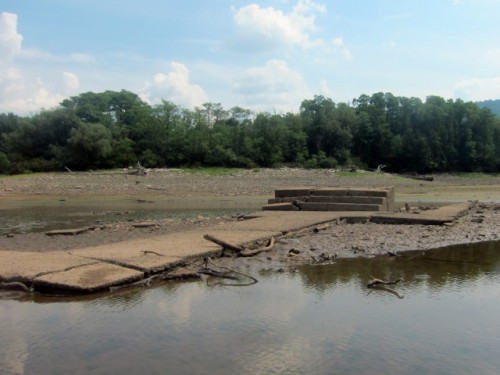
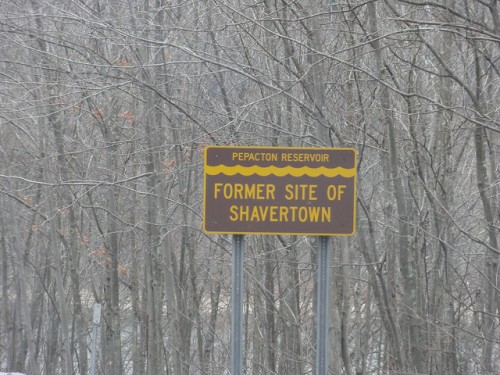
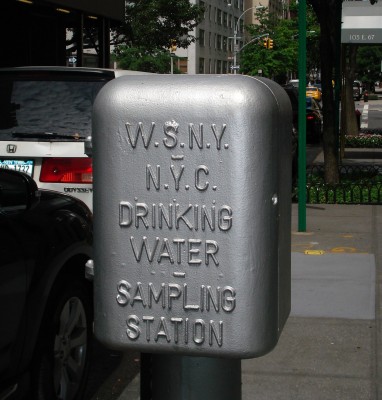
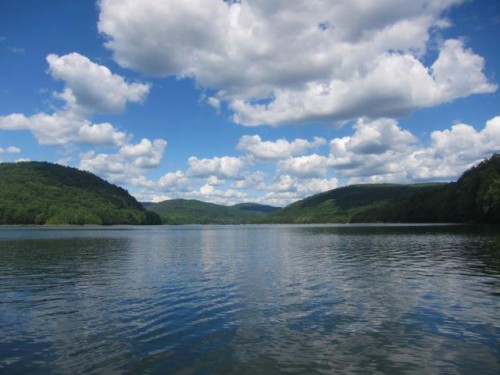
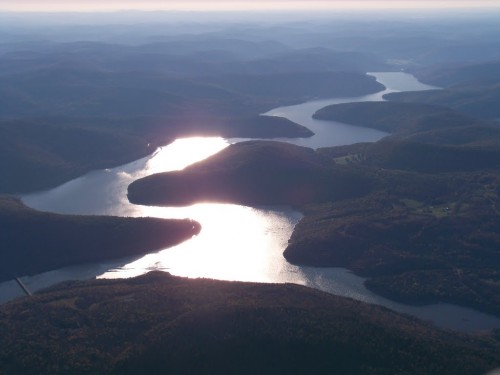


Nicely done Jen. It’s even better hearing it written by someone who is not generational, does not live off the NYC dollar, and has a liberal slant. Still, until one lives here and is wholly invested here, I think the overall depth of the big-picture will always be too much for many to grapple with. With social media, it may be time we let the people of NYC know what is really happening here.
“There is no greater threat to the environment, than poverty.” ~ JFK (?)
BTW – was in Central Park near the Balto statue this summer with the girls, and there was a fountain with a plaque on it explaining “this water comes from the Catskill Mountains” (or something like that). Don’t know if anyone really noticed except for us . . .
Mike — thank you– also I want to find that sculpture. That might be in my followup. In fact had I known about it, it would have made it somehow into the piece… As an outsider who’s come here, I find the issues fascinating and weird and in a way the heart of what I want to write about these days…
Dear Jen, what a tale.
It resonates with us here at the end of a dirt track in Cornwall where it rains so hard, it astonishes me that we ever fight over water.
Sticking me head up out of the rural cloud for a minute, I do think our big cities are myopic about resources. As you said when you likened it to ‘lecky’, these abstract utilities are the white rabbits of our lives, pooping out of top hats at the first sign of thirst or nightfall.
Mike’s right when he says it’s a two-sided rant. The tough part is adopting an osmotic perspective.
Pass me the semi-permeable catsuit.
Love
Pete
xx
My dear Mr Kirby,
At least when the apocalypse breaks out, which Sam Sattin promises is coming soon to pop culture near you if not your actual neighborhood, we rural dwellers will have a leg up. Oh and I went hunting yesterday…
Miss you there in dirt-track-road Cornwall-land. Give my love to the Mrs Kirby…
I can assure you both that any apocalypse that comes under my assurance will be soft and cuddly. Doom by kittens. Meow.
Kittens? But wait I’m learning to hunt.